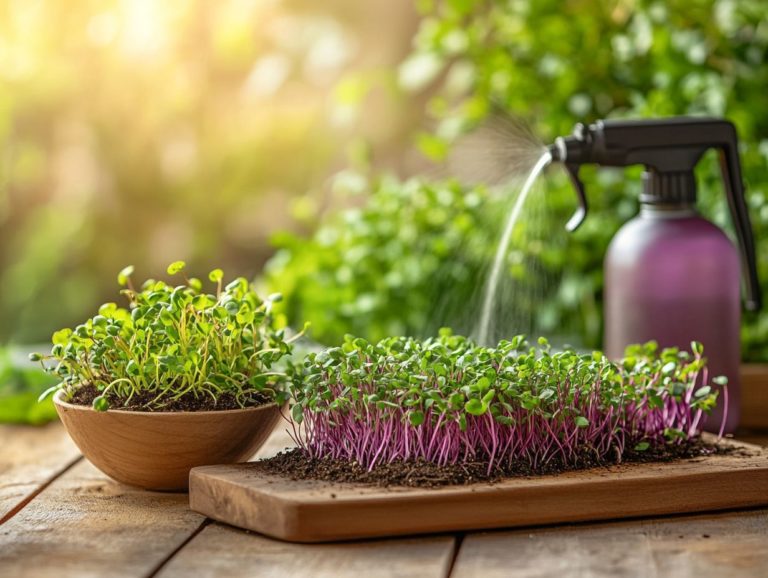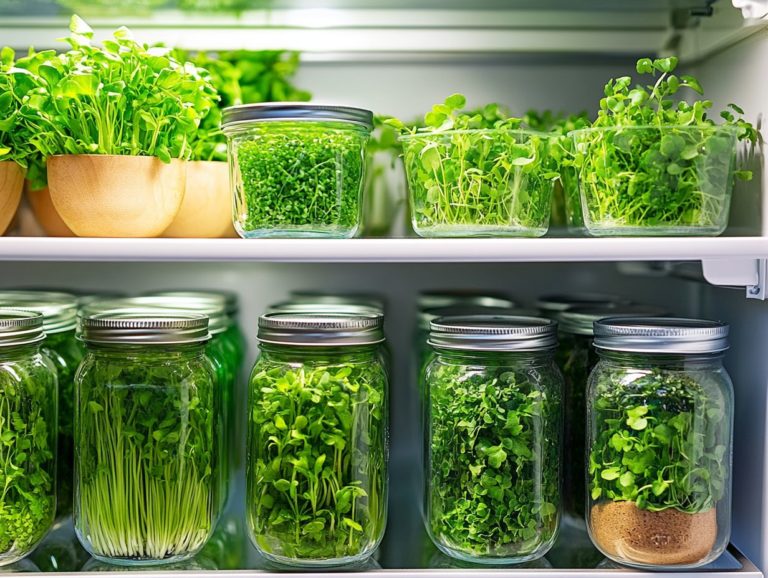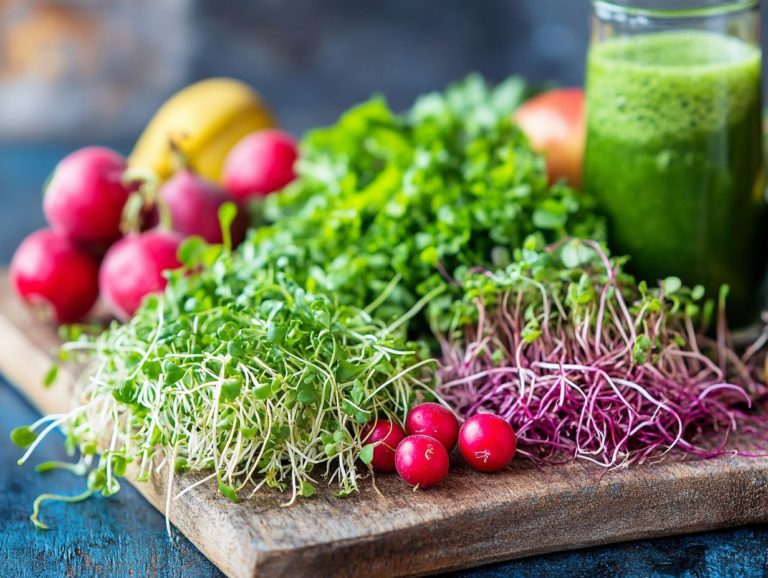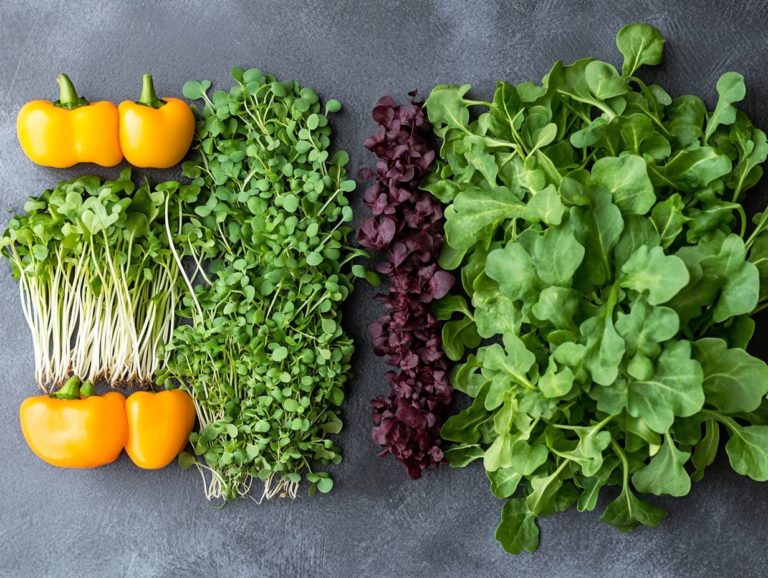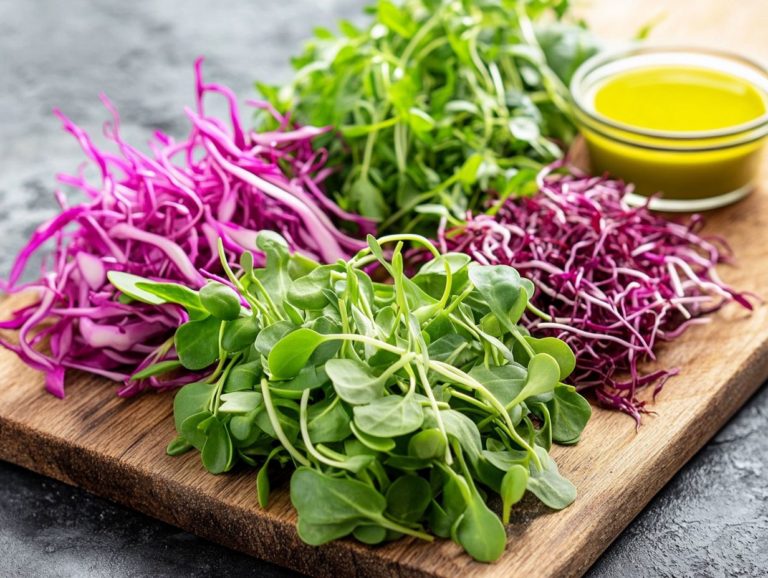Microgreens and Their Role in a Plant-Based Diet
Microgreens are small yet mighty plants. They are brimming with nutrients and have captured the attention of health enthusiasts for their vibrant flavors.
This article delves into the world of microgreens, exploring their advantages in a plant-based diet and offering guidance on how to grow and utilize them effectively.
Uncover the various types of microgreens that can elevate your meals, as well as some potential risks to keep in mind, such as contamination risks from E. coli.
Whether you re a seasoned connoisseur of plant-based eating or simply curious about integrating these greens into your diet, you ll find valuable insights tailored for you.
Contents
- Key Takeaways:
- What are Microgreens?
- Benefits of Incorporating Microgreens into a Plant-Based Diet
- How to Grow and Use Microgreens
- Choosing the Right Microgreens for Your Diet
- Potential Risks and Precautions
- Frequently Asked Questions
- What are microgreens and how do they fit into a plant-based diet?
- What nutrients do microgreens contain?
- How do microgreens benefit a plant-based diet?
- Is it easy to incorporate microgreens into a plant-based diet?
- Can microgreens be grown at home?
- Are there any precautions to take when consuming microgreens in a plant-based diet?
Key Takeaways:
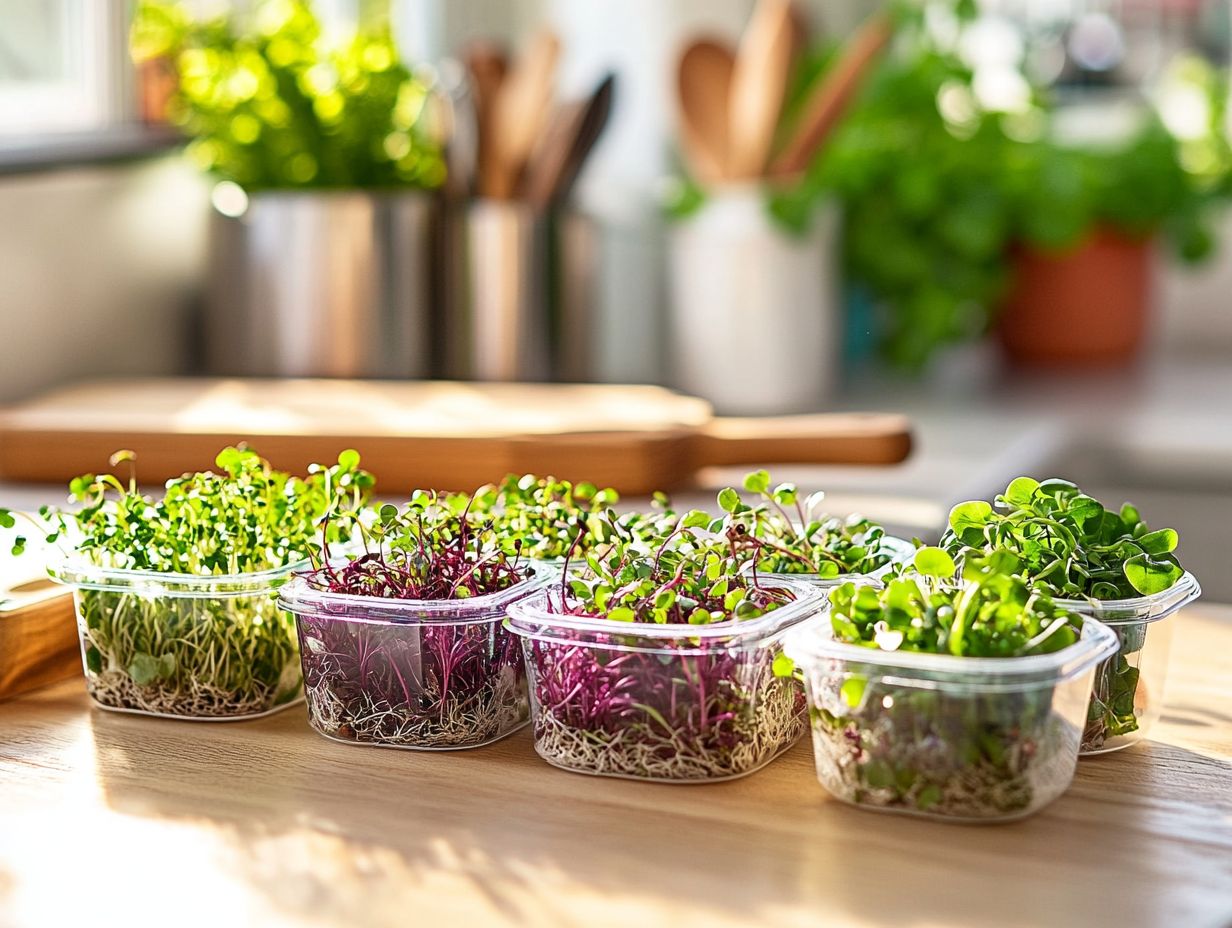
- Microgreens pack a powerful nutrient punch, making them a trendy choice for health enthusiasts!
- Including microgreens in a plant-based diet can provide increased nutrient intake, promote better digestion and gut health, and assist in improving insulin resistance.
- Growing and using microgreens is easy and can be incorporated into meals in various ways, adding flavor enhancement and nutrition to dishes.
What are Microgreens?
Microgreens are vibrant little wonders that pack an exciting punch of flavor and nutritional richness. Harvested just after their first true leaves emerge, these petite greens not only enhance the visual appeal of your dishes but also provide a sustainable method for health-conscious individuals like you to infuse concentrated nutrients into your diet.
With a delightful array of varieties, such as broccoli and fenugreek from the Brassicaceae family, microgreens serve as a versatile ingredient in countless culinary creations. Embracing microgreens also positively impacts the environment, championing the cause of urban farming.
Definition and Nutritional Value
Microgreens are the young seedlings of edible vegetables, herbs, or other plants that you can harvest right after the first true leaves have developed. These tiny greens boast an impressive nutritional profile, packed with high levels of vitamins A and E, dietary fiber, and essential minerals.
These little powerhouses offer remarkable nutritional density, serving as a concentrated source of antioxidants that combat damage to your cells caused by free radicals. The health benefits of microgreens go well beyond their vibrant colors; they re rich in essential vitamins like K and C, and loaded with vital minerals such as potassium and magnesium.
When you incorporate these greens into your diet, you not only enhance flavor and texture but also contribute to your overall well-being. They support immune function and promote heart health. With a diverse array of microgreens available, you can enjoy a wide spectrum of nutrients, making them a must-have for the health-conscious individual. To learn more about their advantages, check out the health benefits of microgreens explained.
Benefits of Incorporating Microgreens into a Plant-Based Diet
Incorporating microgreens into your plant-based diet presents a wealth of health benefits. For the health-conscious individual, these tiny powerhouses deliver a concentrated punch of nutrients that can significantly enhance your overall wellness and support a variety of health goals.
Increased Nutrient Intake
Microgreens are celebrated for their exceptional nutritional density, often surpassing their mature counterparts in vitamins, minerals, and antioxidants. This makes them a remarkable addition to your diet if you’re looking to enhance your nutrient intake.
These young seedlings, including varieties like broccoli, kale, and radish, are particularly recognized for their potent antioxidant properties, significantly benefiting your overall health. Take broccoli microgreens, for example; they are loaded with sulforaphane, a compound renowned for its anti-cancer effects. Meanwhile, red cabbage microgreens offer an impressive array of polyphenols, vital for combating oxidative stress. Additionally, exploring the role of microgreen varieties in plant-based diets can further enhance your nutrition.
By incorporating a diverse selection of these nutrient-packed greens into your meals, you not only elevate flavors but also enhance your overall nutrient profile. It’s a simple yet effective way to boost your daily vitamin and mineral intake seamlessly.
Improved Digestion and Gut Health
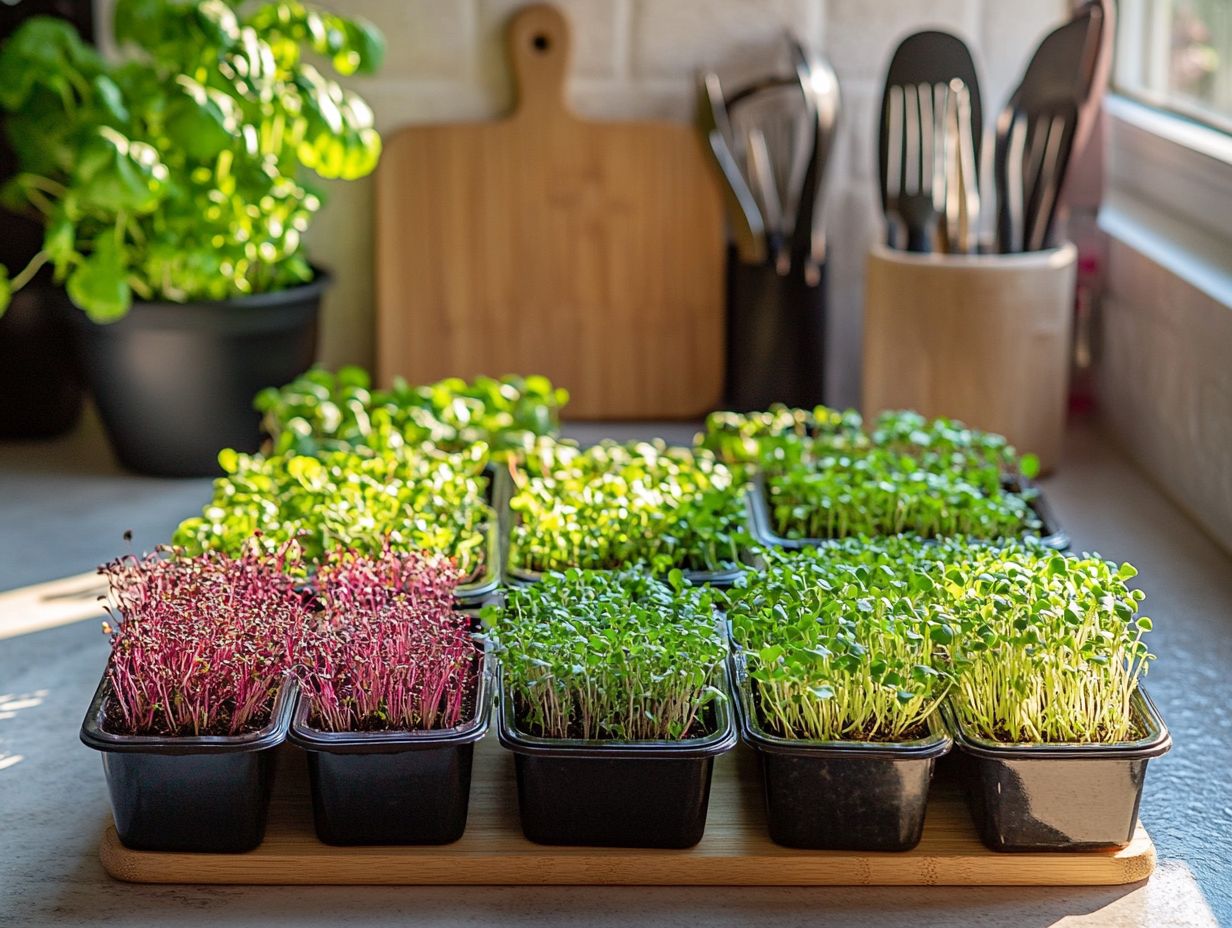
Incorporating microgreens into your diet can greatly enhance your digestion and gut health. Many varieties are packed with dietary fiber, which supports regularity and helps prevent iron deficiency.
Health professionals frequently highlight the importance of including fresh greens in your daily meals. Not only do they boost your fiber intake, but they also provide a rich array of vitamins and minerals.
Take broccoli and kale microgreens, for instance; these tiny greens are particularly renowned for their benefits in promoting a well-functioning digestive system. They re full of nutrients and actively contribute to enhancing your gut microbiome, a key player in digestion.
Enjoying these vibrant superfoods can improve your digestion and overall well-being, and even prevent conditions like gastroparesis.
How to Grow and Use Microgreens
Growing microgreens is a remarkably simple process that gives you the power to relish fresh produce right in your own home. With a plethora of varieties available, you can enjoy quick growth and require minimal garden space making them the perfect choice for those passionate about urban farming.
Step-by-Step Guide to Growing Microgreens
To grow microgreens, begin by selecting the variety that catches your eye, preparing the soil or growing medium, and ensuring you have sufficient light and water to promote their swift growth in ideal growing conditions.
When choosing seeds like radish, kale, or arugula, think about the flavors and nutritional benefits that align with your palate. Once you’ve made your selection, evenly spread the seeds in your prepared container and lightly cover them with a thin layer of soil.
Water them gently to avoid displacing the seeds. Then place the container in a spot that receives at least 12 hours of light each day whether from natural sunlight or grow lights.
Keep a close eye on the soil moisture to steer clear of overwatering. In just a week or two, you ll be ready to harvest the microgreens at the true leaf stage.
Not only will you elevate your meals with fresh flavors, but you ll also be adding a boost of vitamins and minerals to your diet.
Ways to Incorporate Microgreens into Meals
Microgreens can be seamlessly woven into your meals, infusing them with a burst of flavor and nutrition. Whether you’re crafting a refreshing salad, a gourmet sandwich, or a revitalizing smoothie, these tiny greens have won the hearts of health enthusiasts and culinary aficionados alike.
Packed with concentrated nutrients, microgreens can significantly elevate the health benefits of any dish. Imagine adding peppery arugula microgreens to a hearty wrap; they create a delightful contrast with creamy spreads.
Alternatively, consider sweet pea shoots as a fresh, crisp addition to a vibrant fruit salad. These miniature plants also make stunning garnishes for soups, enhancing both visual appeal and flavor.
With their diverse flavor profiles, ranging from earthy to spicy, microgreens not only enhance the quality of your meals but also invite a culinary adventure that sparks creativity in your kitchen.
Choosing the Right Microgreens for Your Diet
Selecting the ideal microgreens for your diet requires a thoughtful exploration of the various types available, each boasting its own unique nutritional profile. This understanding not only enhances the flavors of your meals but also offers specific health benefits that cater to your individual needs.
Explore various types of microgreens to find the perfect match for your taste buds and health goals!
Types of Microgreens and Their Nutritional Profiles

You ll find a diverse array of microgreens, each boasting its own unique nutritional profile. Take broccoli microgreens, for example they’re packed with antioxidants, which help combat cell damage, and can assist in managing bad cholesterol (LDL) levels, making them a powerhouse for your health.
Radish microgreens also deserve a spotlight, showcasing impressive vitamin C content that enhances your immune system while adding a delightful spicy kick to your salads.
And don t overlook pea shoots; they are rich in vitamins A and K, supporting bone health and improving vision.
Beet microgreens are celebrated not just for their vibrant hue but also for their high folate levels, which play a vital role in heart health.
By weaving these nutrient-dense greens into your daily meals, you can significantly boost your nutritional intake.
Understanding the Health Benefits of Microgreens empowers you to make informed dietary choices, allowing you to leverage their exceptional nutritional density for your overall well-being.
Potential Risks and Precautions
While microgreens are typically safe and packed with nutrition, it’s essential to recognize that improper handling can lead to contamination risks, especially from pathogens like E. coli.
For health-conscious individuals like yourself, following health guidelines becomes crucial to ensure the safety and quality of these vibrant greens, especially for those managing Type 2 diabetes.
Contamination and Proper Handling
Contamination can happen during the growth or harvesting of microgreens, especially from harmful bacteria like E. coli. This highlights the importance of proper handling and hygiene practices.
The risks become even more pronounced if you don t maintain optimal growing conditions, which means ensuring the best environment for plants to thrive. Think inadequate sanitation, contaminated water, or unclean tools.
To minimize potential hazards, it s essential to ensure that all equipment is thoroughly sanitized before and after use, and to utilize clean water that meets safety standards.
Health professionals recommend that you wear gloves and wash your hands meticulously when handling microgreens to prevent the transfer of bacteria from your skin.
It’s also wise to harvest microgreens during the cooler parts of the day and store them in a clean, cool environment to keep bacterial growth at bay. Regularly checking for signs of spoilage is crucial to maintaining both the quality and safety of your produce.
Frequently Asked Questions
What are microgreens and how do they fit into a plant-based diet?
Microgreens are young vegetable greens that are harvested just after the first leaves have developed. They are a concentrated source of nutrients and can be used in a variety of dishes, making them a great addition to a plant-based diet.
What nutrients do microgreens contain?
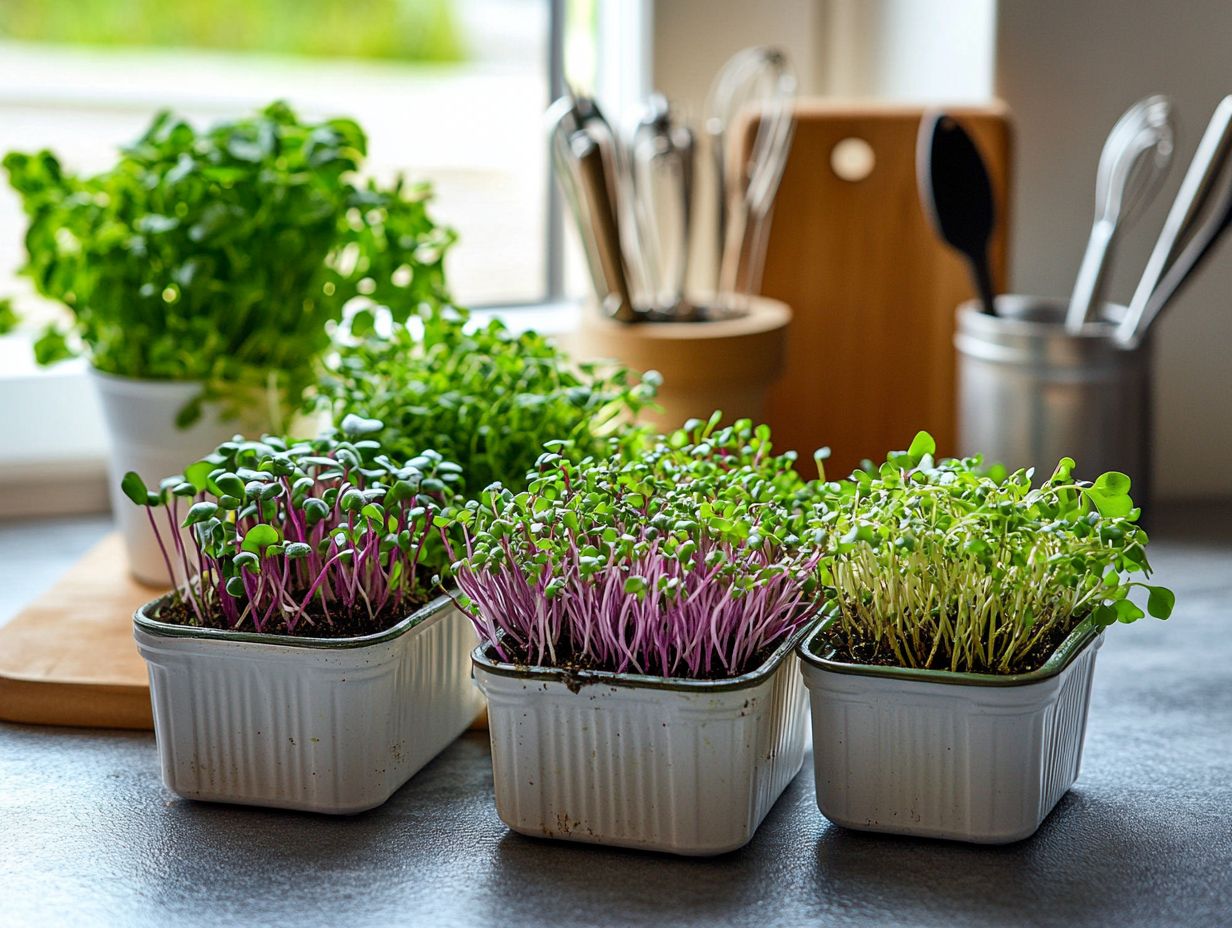
Microgreens are packed with a variety of vitamins, minerals, and antioxidants. They are particularly high in vitamins C, E, and K, as well as beta-carotene and lutein, which help support your health.
How do microgreens benefit a plant-based diet?
Microgreens provide a wide range of nutrients that are essential for maintaining a healthy plant-based diet. They can help boost immunity, support eye health, and provide an abundance of antioxidants.
Is it easy to incorporate microgreens into a plant-based diet?
Yes, microgreens are incredibly versatile and can be easily incorporated into a plant-based diet. They can be added to salads, sandwiches, smoothies, and even used as a garnish for soups and main dishes.
Can microgreens be grown at home?
Yes, microgreens can be easily grown at home with minimal equipment and space. They require little maintenance and can be harvested in just a few weeks.
Are there any precautions to take when consuming microgreens in a plant-based diet?
While microgreens are generally safe to consume, it is important to wash them thoroughly before consumption to remove any potential bacteria or contaminants. It is also recommended to consume a variety of microgreens to ensure a well-rounded nutrient intake.


